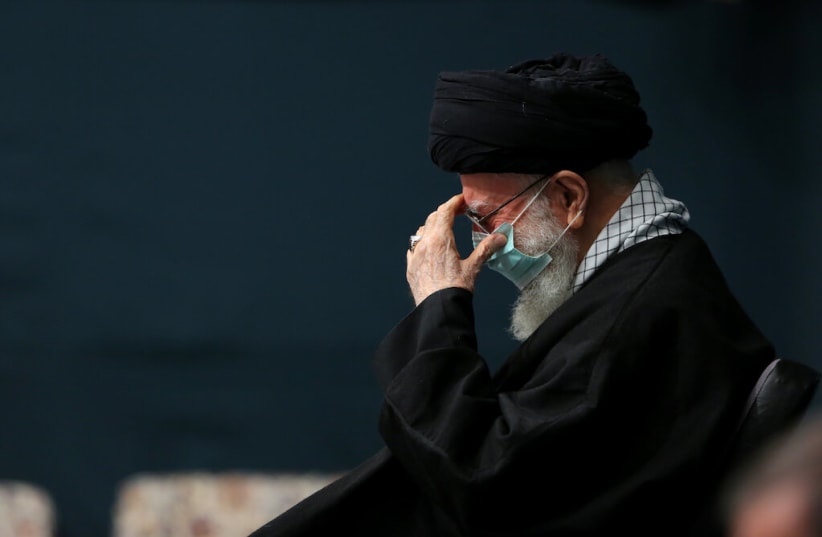Two Islamic Revolutionary Guard Corps (IRGC) officials hinted at division among Iran's leadership as anti-government protests continued to sweep the country in the past week.
Hamid Abazari, an IRGC official who formerly served as deputy commander of the Imam Hossein Training and Officer College, stated that senior commanders and officials had "failed and stood against values, [Supreme Leader Ali Khamenei] and the regime," during the ongoing wave of protests in a speech last week reportedly broadcast on the local Tabarstan network.
Abazari also expressed condemnation of officials who had not condemned the protests and added that "first-rate officials of the regime" were among those who had stood against Khamenei.
The IRGC's public relations department rejected Abazari's statements on Saturday, stressing that this was Abazari's personal opinion and "does not correspond to the existing facts."
Additionally, Gholamhossein Gheybparvar, an IRGC commander in charge of a unit tasked with confronting protests and riots, criticized "some elites" for staying silent about the protests.
"Some elites were afraid of being harmed and damaged in their world and kept silent and were rejected, and you should know that religiosity does not come and go slowly, but religiosity has a cost," said Gheybparvar on Saturday, according to Iranian media.
"In these two or three months, many were rejected; We do not deny the economic problems, high prices, unemployment, etc., but was it the right of the regime that anyone who comes can insert a knife into the body of the regime?"
The Critical Threats Project (CTP) at the American Enterprise Institute noted that "the protests and regime crackdown have fractured the Iranian political and security establishments."
Criticism of the government from Iranian clerics and officials has increased in recent months amid the protests.
A special bulletin prepared by media experts for IRGC commander-in-chief Hossein Salam leaked by the Black Reward hacktivist group cited "some experts" as saying that there is an "accumulation of doubts and uncertainty" among the "revolutionary forces." Additionally, the Fars officials noted that the protest movement "considers the greatest achievement of the recent riots to be the loss of people's fear of the military and police forces."
Recently, Mohammad Sadr, a member of Iran's Expediency Council which advises Iran's supreme leader, warned that while the protests have largely avoided economic slogans, the deteriorating economic situation in Iran could spark economic protests "which is very dangerous," in an interview with the Iranian Donya-e-Eqtesad newspaper.
The Iranian official added that "dialogue is the best solution" for the ongoing unrest.
"One hundred percent of the demands of the protesters are not impractical, and we can implement some of these demands over time in order to de-complex a little and move towards a peaceful country. If we don't use this method, we will be forced to continue the previous security methods that even if these protests seem to be reduced or collected, will still remain in the heart of society, youth and political figures and will continue to resurface," warned Sadr.
Anti-government protests continue across Iran
Anti-government protests continued in multiple locations throughout Iran on Saturday, including Tehran, Javanroud, Sanandaj, Najafabad and Semirom over 100 days since they began. The protests continued into the night, with many protesters chanting anti-government slogans from their rooftops.
#تهران مردم در بازار تهران با شعار #مرگ_بر_دیکتاتور در برابر ماموران سرکوبگر تا دندان مسلح ایستادگی میکنند pic.twitter.com/Tir5AyIKLE
— Iranworkers (@iranworkers) December 31, 2022
Protesters gathered at the Tehran Grand Bazaar, facing off against Iranian security forces. In Qom, protesters torched a post featuring former IRGC Quds Force commander Qassem Soleimani. In Javanroud, a large crowd gathered at the funeral of murdered protester Borhan Elyasi and chanted "death to the dictator."
#جوانرود فیلمی از درگیری نیروهای سرکوبگر با مردم در خیابانهای جوانرود صدای ممتد تیراندازی سرکوبگران شنیده میشود pic.twitter.com/OVn1KsWMXN
— Iranworkers (@iranworkers) December 31, 2022
Protesters and Iranian forces were reportedly clashing in Samirom on Sunday as well, according to the 1500tasvir account.
#سمیرمتظاهرات مردم بعد از مراسم چهلم در مقابل فرمانداری «نترسید نترسید ما همه با هم هستیم»#قیام_تا_سرنگونی pic.twitter.com/myqSeDGhN4
— Iranworkers (@iranworkers) December 31, 2022
Workers at the Arak Refinery, the Abadan refinery and the Azar Mehran oil company went on strike and demonstrated on Saturday in protest against their working conditions.
Iran launches new program to enforce hijab
Iranian authorities launched a new program to enforce the wearing of the hijab in vehicles, sending texts to people who are spotted not wearing the hijab in vehicles, the Fars News Agency reported on Sunday. A similar program was reportedly implemented in Tehran in 2019. In that program, those who received messages were ordered to come to police stations and only released once they signed documents agreeing to wear the hijab. It is unclear how the current program will operate.
The new program comes a month after Iranian officials refuted reports that it had begun closing the "morality police" that enforce the wearing of the hijab.
